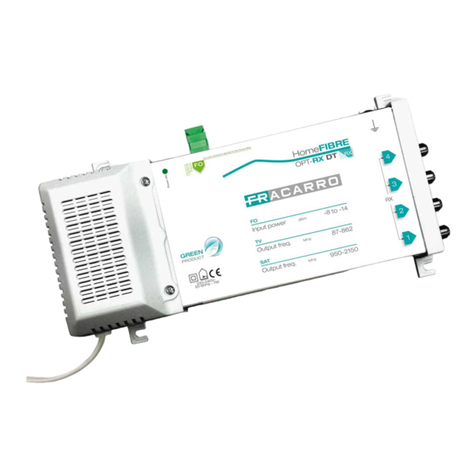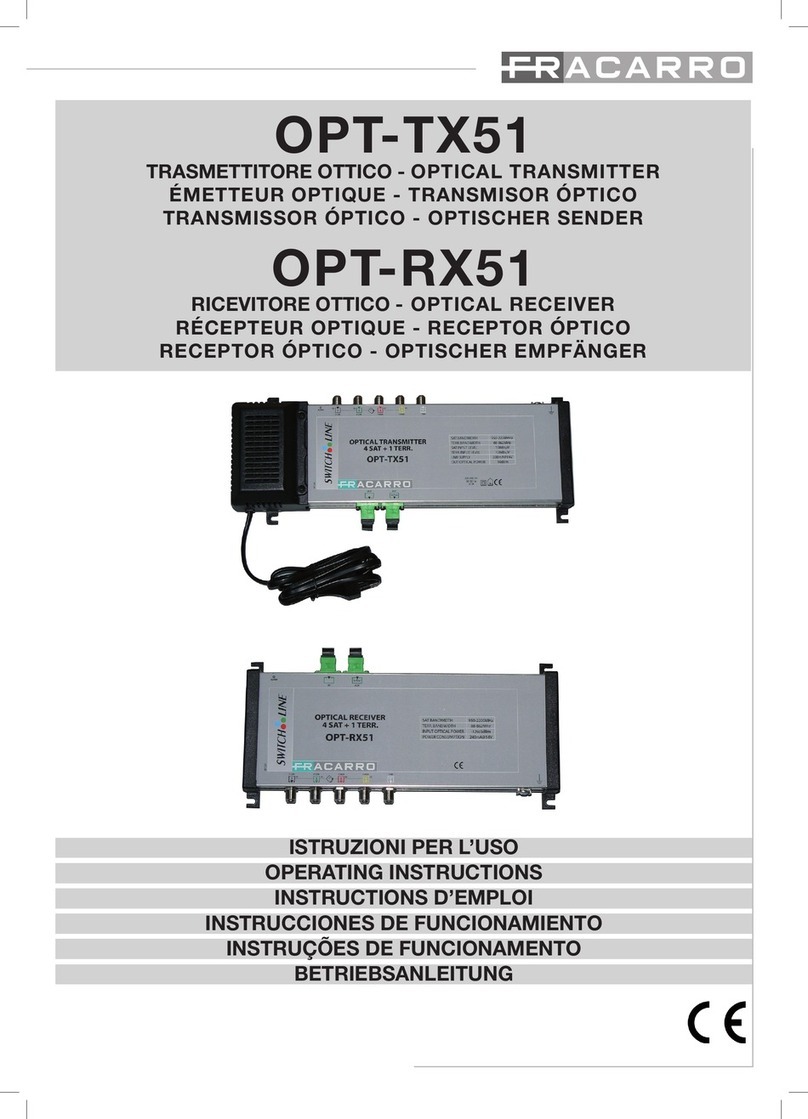
3
Italiano
2. DESCRIZIONE DEL PRODOTTO
L’OPT-TX 15X0 è un trasmettitore ottico per la distribuzione di segnali satellitari e digitali terrestri
su un unico cavo in fibra ottica monomodale. I segnali tradizionali RF in ingresso al trasmettitore
OPT-TX 15X0 vengono convertiti e distribuiti su una fibra ottica monomodale che può essere divisa
tramite partitori e derivatori passivi fino a raggiungere molteplici connessioni ottiche (PON=Passive
Optical Network) con un unico trasmettitore. Il segnale ottico potrà poi essere convertito in RF
tramite i ricevitori OPT-RX DT, OPT-RX QUATTRO o OPT-RX TV. Il prodotto prevede l’utilizzo di
un LNB tradizionale e dispone di 5 uscite passanti (4 SAT + 1 TV) per consentire l’installazione in
cascata di altri trasmettitori o l’applicazione in cascata di un sistema tradizionale a multiswitch.
L’AGC (Controllo Automatico del Guadagno) presente sul trasmettitore facilita la configurazione del
prodotto regolando automaticamente il livello del segnale in ingresso al laser ottico.
SAT IN:
connettori F di ingresso per le quattro polarizzazioni satellitari IF (950 ÷ 2150MHz) con
telealimentazione LNB
TV IN: connettore F per l’ingresso del segnale TV (87 ÷ 862MHz)
TEST SAT: connettore F per l’uscita segnale di test SAT, polarità HH, livello per transponder
60dBuV
TEST TV: connettore F per l’uscita segnale TV 87 ÷ 862MHz, potenza complessiva 74dBuV
OPTICAL OUTPUT: connettore SC-APC di uscita del trasmettitore ottico per il link in fibra
SAT OUT: connettori F di uscita per le quattro polarizzazioni satellitari IF (950 ÷ 2150MHz) per
eventuale connessione in cascata di altri dispositivi
TV OUT: connettore F per l’uscita del segnale TV (87 ÷ 862MHz)
LED alimentazione: acceso (verde) quando il prodotto è alimentato
LED giallo: l’accensione del LED indica la limitazione di corrente del laser.
Messa a terra dell’impianto d’antenna (secondo EN60728-11)
2.1 Funzionamento del sistema:
La distribuzione in fibra ottica ha come impianto di testa un sistema di ricezione di tipo tradizionale e
quindi antenne, parabole e LNB tradizionali ed eventuali centrali di equalizzazione ed amplificazione
dei segnali; i segnali tv e sat vengono inviati ad un trasmettitore ottico OPT-TX 15X0 che trasforma
le variazioni di segnale elettrico in variazioni di segnale luminoso adattando di fatto i segnali per
essere trasferiti a distanza su fibra ottica. La fibra è deputata al trasporto dei segnali.
Ogni qual volta si necessita di dividere questo segnale in più linee al pari degli impianti tradizionali,
si utilizza un dispositivo chiamato divisore ottico o splitter ottico (es. VOV o VOT), il quale suddivide
in più linee di trasporto ottico il segnale senza perdita di qualità, seppur con un’attenuazione
calcolata. Una volta in prossimità dell’unità da servire il segnale ottico viene riconvertito in segnale
tradizionale dai ricevitori ottici (es.OPT-RX DT, OPT-RX QUATTRO, OPT-RX TV) che all’uscita
generano i segnali RF che possono essere messi a disposizione dell’utente finale tramite la
Vista dall’alto OPT-TX 15X0 e indicazioni connettori
}
SAT
Input TV
Input Test
SAT
}
SAT
Output Optical
Output
TV
Output
Test
TV
LED allarme
Connettore di alimentazione
LED alimentazione





























